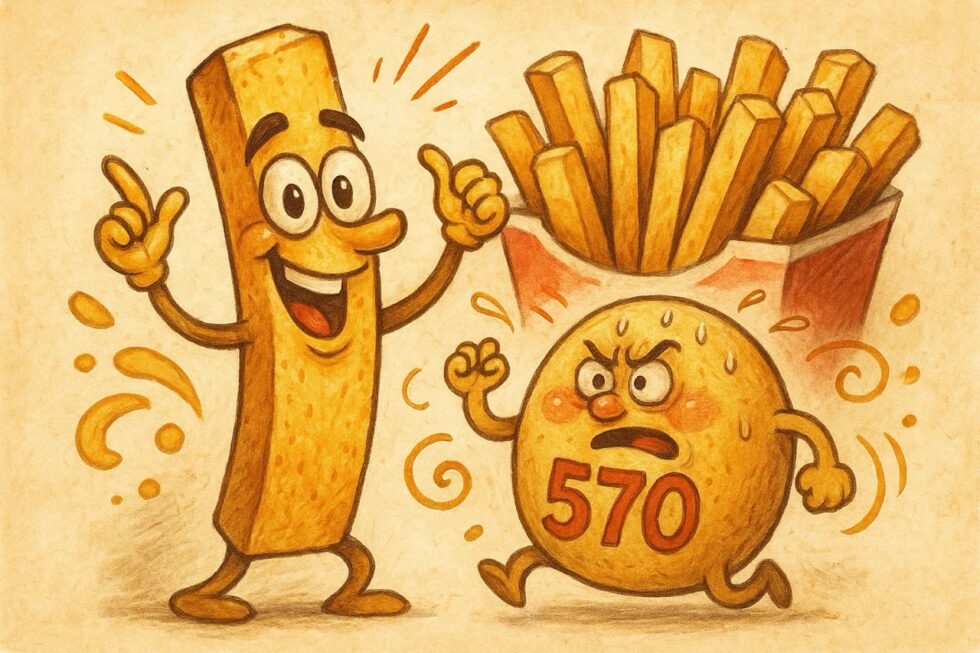Why French Fries Are Celebrated on August 20 – History, Calories and Culture

The origin of French fries has been disputed for centuries, with Belgium and France both claiming to be their birthplace. In Belgium, it is said that fishermen in the city of Namur began frying thin strips of potatoes in the seventeenth century during the winter months when fish was unavailable. In France, the first appearance of “frites” was recorded in Paris in the eighteenth century, where street vendors sold them along the bridges of the Seine, quickly making them part of the everyday food culture. During the First World War, American soldiers encountered the fried potatoes in Europe and brought them back home, popularising them under the name “French Fries.” Today, Belgium alone has more than 5,000 “friteries,” and since 2014 Belgian fries have been recognised by UNESCO as part of the intangible cultural heritage of humanity.
Key Facts:
- Possible origin: Belgium or France
- Seventeenth century: first references in Namur, Belgium
- Eighteenth century: Paris street vendors
- Twentieth century: worldwide spread through American soldiers
- Belgium today: over 5,000 fry shops

Calories and Nutritional Values: What Is Inside French Fries
French fries are energy-dense but poor in nutrients. A portion of one hundred grams contains approximately three hundred to three hundred and twenty calories, which is nearly four times more than the same amount of boiled potatoes. In addition, fries provide thirty-five to forty grams of carbohydrates and fifteen to twenty grams of fat, often from palm oil or hydrogenated oils. Their high salt content can increase the risk of high blood pressure, while acrylamide, a substance formed during frying at high temperatures, is considered potentially carcinogenic. Despite these risks, French fries still provide potassium, a small amount of vitamin C, and can serve as a quick source of energy, especially after physical exertion. However, regular consumption should be limited to avoid health issues.
Nutritional values per 100 g of French fries
- Calories: 300–320 kcal
- Fat: 15–20 g
- Carbohydrates: 35–40 g
- Protein: 3–4 g
- Salt: 1–1.5 g
Glycaemic Index: Potatoes versus Sweet Potatoes
The glycaemic index (GI) measures how quickly carbohydrates raise blood sugar levels. French fries are among the highest in this category, with a GI of seventy-five to ninety, which leads to rapid blood sugar fluctuations. Boiled potatoes have a GI of around seventy, while sweet potatoes are much lower at about fifty, making them more suitable for people with diabetes and athletes. Sweet potatoes also contain more beta-carotene, vitamin A, and dietary fibre. Because of these qualities, sweet potatoes are considered a “trendy vegetable” and are increasingly served in restaurants as a healthier alternative to traditional fries.
Comparison table – potatoes versus sweet potatoes
| Product | GI value | Calories per 100 g | Advantages | Disadvantages |
|---|---|---|---|---|
| Boiled potato | ~70 | ~77 kcal | Filling, low in calories | High GI |
| French fries | 75–90 | ~300–320 kcal | Crispy, popular | High fat, acrylamide |
| Boiled sweet potato | ~50 | ~86 kcal | Vitamin A, fibre | Sweet flavour not for all |
| Sweet potato fries | 60–70 | 150–200 kcal | Healthier, lower GI | Less crispy, more costly |
Who Should Avoid Eating French Fries
French fries are not equally suitable for all groups of people. Individuals with diabetes should avoid them due to their very high glycaemic index. People with heart and circulation problems are at risk because of the combination of fat and salt. Overweight individuals also should be cautious, since fries are calorie-dense and can easily lead to weight gain. For children, fries can become addictive due to their taste and rewarding character, and therefore consumption should be limited. For athletes or individuals with very high energy needs, fries can occasionally be useful as a quick source of carbohydrates, but only in moderation.
Groups at particular risk:
- People with diabetes (high GI)
- Individuals with high blood pressure
- People with overweight or obesity
- Children with unhealthy eating habits
- Patients with heart or vascular diseases
Names of French Fries in Different Languages
French fries are a global dish and are called differently in each country, reflecting their cultural significance. In Germany, they are called “Pommes” or “Pommes frites.” In the United States and the United Kingdom, the common name is “French Fries.” In France, they are simply “Frites.” In the Netherlands, they are known as “Friet” or “Patat.” In Spain they are called “Papas fritas,” in Italy “Patatine fritte,” in Poland “Frytki,” and in Russia “Картофель фри.” In Japan, the term “フライドポテト (Furaido Poteto)” is used, while in Arabic they are “بطاطا مقلية (Batata Maqliya).”
Top-10 international names of French fries
- Germany – Pommes frites / Pommes
- United States / United Kingdom – French Fries
- France – Frites
- Netherlands – Friet / Patat
- Spain – Papas fritas
- Italy – Patatine fritte
- Poland – Frytki
- Russia – Картофель фри
- Japan – フライドポテト (Furaido Poteto)
- Arabic-speaking countries – بطاطا مقلية (Batata Maqliya)
Prices of French Fries Around the World
The price of a portion of French fries varies depending on the country and its purchasing power. In Germany, the average price in a snack bar is three euros, in France three euros fifty, and in Belgium three euros twenty. Switzerland is among the most expensive countries, with an average of five francs fifty per portion. In the United States, fries cost approximately three dollars eighty, in the United Kingdom around three pounds twenty. In Poland, a portion costs twelve zlotys, around two euros eighty, and in India just eighty rupees, around ninety euro cents.
Average prices for French fries (2025, per portion)
| Country | Price in local currency | Price in € |
|---|---|---|
| Germany | 3.00 € | 3.00 € |
| France | 3.50 € | 3.50 € |
| Belgium | 3.20 € | 3.20 € |
| Switzerland | 5.50 CHF | 5.70 € |
| United States | 3.80 $ | 3.50 € |
| United Kingdom | 3.20 £ | 3.70 € |
| Poland | 12 PLN | 2.80 € |
| Russia | 250 RUB | 2.50 € |
| Japan | 500 Yen | 3.00 € |
| India | 80 INR | 0.90 € |
In Which Countries Are French Fries the Most Popular
French fries are one of the most consumed foods worldwide and belong to the top three side dishes alongside rice and pasta. In Belgium they are regarded as a national dish, with an average of seventy-five portions eaten per person every year. In the United States, more than 4.5 million tons of fries are consumed annually, which equals about fifteen kilograms per capita. In Germany the average is eight kilograms per person per year. In France, fries are a traditional accompaniment to “steak frites,” while in the United Kingdom they form an integral part of the iconic “Fish and Chips.” In the Netherlands, Japan, and Russia, fries have also become part of the established food culture.
Top countries by consumption
- Belgium – 75 portions per person per year
- United States – 15 kg per person per year
- Germany – 8 kg per person per year
- France – fries with “steak frites”
- United Kingdom – fries as part of “Fish and Chips”

Tips: How to Eat French Fries More Healthily
French fries do not always have to be unhealthy, as much depends on preparation and portion size. Instead of deep-frying, it is better to bake them in the oven or prepare them in an air fryer, which reduces fat content by up to seventy percent. Rapeseed oil or olive oil are healthier choices than palm oil. Instead of too much salt, one can use herbs such as rosemary, thyme, or paprika for flavour. A healthy portion is considered to be one hundred to one hundred and fifty grams, ideally combined with vegetables or protein such as fish or chicken. Industrially frozen fries should be avoided whenever possible, since they often contain additives.
Practical tips
- Use oven or air fryer instead of deep fryer
- Choose rapeseed oil or olive oil instead of palm oil
- Season with herbs instead of salt
- Limit portion size to 100–150 g
- Combine with vegetables and protein
- Prefer fresh potatoes over frozen products
Health Benefits and Risks of French Fries
French fries are a food full of contrasts: they can deliver quick energy, but they are also rich in fat, salt, and calories. For some groups of people they may be useful, for others they can be harmful. Athletes may benefit from them as a fast source of carbohydrates after exercise. Children, however, can easily become accustomed to the taste and associate it with reward, increasing the risk of obesity. Senior citizens may find fries an easy source of energy, but they also pose risks for heart and vascular health. For diabetics, fries bring almost no benefits and carry significant risks due to their high glycaemic index.
Health evaluation by group
| Group | Possible benefits | Risks |
|---|---|---|
| Children | Quick energy, enjoyable taste | Obesity, unhealthy eating habits |
| Adults | Satiating, social eating culture | High calories, blood pressure, CVD |
| Senior citizens | Easy energy intake | Risk of diabetes type 2, digestion issues |
| Athletes | Fast carbohydrate source | Harmful if eaten too often, trans fats |
| Diabetics | Practically none | High GI, blood sugar fluctuations |
World French Fries Day on August 20
Every year on August 20 the World French Fries Day is celebrated. The day was established in the early 2000s by associations in Belgium and the United States connected with the potato industry. The idea was to highlight the cultural and economic significance of French fries. In Belgium, fry shops often offer free portions on this day, while in the United States fast-food chains promote special offers and menus. The date was chosen to coincide with the end of the summer potato harvest in Europe and the start of the high consumption season. On social media, the day is marked by photos, recipes, and creative dishes, making it a global event.
Reasons for the celebration:
- Recognition of culinary tradition
- Marketing campaigns for restaurants and food industry
- Symbol of Belgian and French food culture
- Global social media phenomenon
- Reminder of the worldwide success of the potato
Famous People Who Love French Fries
French fries are not only popular among the general public, but also among celebrities worldwide. Former United States President Barack Obama has been photographed several times eating burgers with fries. Donald Trump is well known for his preference for fast food, including French fries from McDonald’s. Model Gigi Hadid has called fries her favourite food in interviews. Singer Ed Sheeran has repeatedly shared his love for fries and ketchup on social media. Former German Chancellor Angela Merkel was often seen eating currywurst with fries during election campaigns. Football star David Beckham admitted that fries are part of his “cheat meals.” Pop star Katy Perry even dressed up as a portion of fries at the MTV Awards in 2015. Tennis champion Serena Williams mentioned that fries are among her small pleasures outside the sport. Actor Brad Pitt has been photographed eating fries in restaurants, while model Heidi Klum has described fries as her typical “comfort food.”
Stay connected for news that works — timely, factual, and free from opinion — and insights that matter now: Why Jack Daniel’s Is Betting on Blackberry Whiskey – and What It Means for the Market